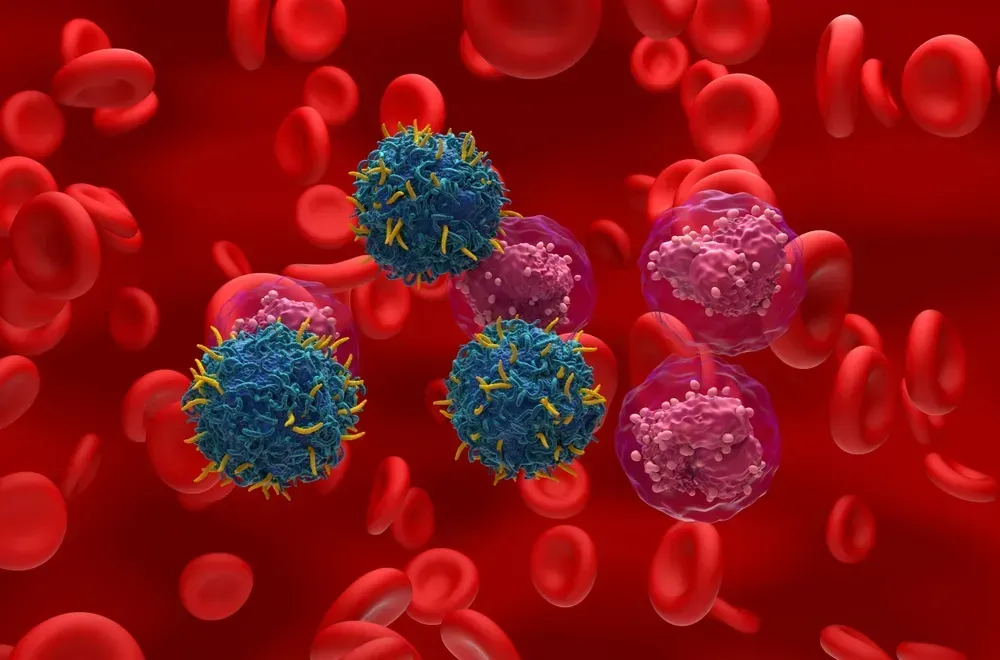Risk of Infections Using Bispecific Antibodies in Multiple Myeloma

A 2023 research report of pooled bispecific antibody clinical trial data shows that infections can be common and that more studies are needed to determine how to best reduce patient infection rates.
The authors start an article in the journal Blood Advances (2023) with a bang:
“The use of bispecific antibodies (BsAbs) in the treatment of relapsed/refractory multiple myeloma (MM) is showing early promising overall response rates in heavily pre-treated patients. Infectious complications related to the use of BsAbs are not well described.”
This research article summarizes a pooled analysis of 11 published clinical studies with 11 different bispecific antibodies, covering 1,185 myeloma patients. In these studies, bispecific antibodies were administered as a single agent to patients with no prior exposure to another bispecific antibody.
Let’s pause for a minute and re-hash some education about bispecifics.
Bispecific antibodies bind to a target on the cancerous myeloma (plasma) cells and immune effector cells, resulting in cell death of the malignant cell. Bispecific antibodies used in myeloma can target BCMA (which we are most familiar with from the more popular myeloma press) or the protein GPRC5D or FcRH5.
The products included in this study can be categorized as follows:
BCMA Targeted Bispecific Antibodies
- Teclistamab (JNJ/Janssen - FDA approved)
- Elranatamab (Pfizer – FDA approved)
- Linvoseltemab (Regeneron, clinical trial stage)
- ABBV-383 (Amgen, in Phase III clinical trial as of July 2024)
- Alnuctamab (Bristol Myers – clinical trial stage)
GPRC5D Targeted Bispecific Antibodies
- Talquetamab (JNJ/Janssen - FDA approved)
- Forimtamig (Genentech)
FcRH5 Targeted Bispecific Antibodies
- Cevostamab (Genentech – clinical trial stage)
Infection Rate and Therapy Target Correlation
In the pooled data clinical trial mentioned above, infections of any grade were reported in 50% of the patients, with grade 3/4 infections occurring in approximately 25% of the patients. Patients who received BCMA-targeting bispecific antibodies had a higher risk (30%) than those treated with non-BCMA targeting bispecifics, such as talquetamab or cevostamab (12%).
Why Is There Such a High Infection Rate with Bispecific Antibody Therapy?
According to the study, there are three main reasons high infection rates occur in multiple myeloma patients who have received a bispecific antibody therapy.
- Almost all the patients receiving the bispecific therapy had been treated with other forms of therapy, thus making them immunocompromised due to the depletion of plasma cells.
- Side effects of bispecific antibody therapies include low blood and plasma cell counts, such as neutropenia, lymphopenia, and hypogammaglobulinemia. The authors reported that nearly 39% become neutropenic while using bispecifics, and more importantly, nearly 35% of patients report grade 3/4 neutropenia.
- Cytokine release syndrome, another common side effect of bispecific antibody therapy, is treated with immunosuppressive agents like glucocorticoids, tocilizumab, and other treatments that indirectly cause further immunosuppression.
Because of the low levels of antibodies, patients are more susceptible to infection.
What Can Be Done to Prevent or Treat Infection With Bispecific Antibody Therapy?
The authors of the study above provided their thoughts on what can be done to prevent or treat infections for myeloma patients on bispecific antibody therapy. These ideas are summarized below.
- A standardized set of guidelines detailing prophylactic (preventative) medications and/or IVIG are needed for treating myeloma patients with bispecific antibody therapy. The use of these medications can help decrease the risk of infections/infection complications.
- Better efforts should be made to capture infectious complications and report them to help guide treating physicians. Baseline and periodic tests are needed to detect infections earlier.
Patients currently being treated with bispecific antibodies may wish to discuss some of these recommendations with their myeloma specialist.
A 2023 research report of pooled bispecific antibody clinical trial data shows that infections can be common and that more studies are needed to determine how to best reduce patient infection rates.
The authors start an article in the journal Blood Advances (2023) with a bang:
“The use of bispecific antibodies (BsAbs) in the treatment of relapsed/refractory multiple myeloma (MM) is showing early promising overall response rates in heavily pre-treated patients. Infectious complications related to the use of BsAbs are not well described.”
This research article summarizes a pooled analysis of 11 published clinical studies with 11 different bispecific antibodies, covering 1,185 myeloma patients. In these studies, bispecific antibodies were administered as a single agent to patients with no prior exposure to another bispecific antibody.
Let’s pause for a minute and re-hash some education about bispecifics.
Bispecific antibodies bind to a target on the cancerous myeloma (plasma) cells and immune effector cells, resulting in cell death of the malignant cell. Bispecific antibodies used in myeloma can target BCMA (which we are most familiar with from the more popular myeloma press) or the protein GPRC5D or FcRH5.
The products included in this study can be categorized as follows:
BCMA Targeted Bispecific Antibodies
- Teclistamab (JNJ/Janssen - FDA approved)
- Elranatamab (Pfizer – FDA approved)
- Linvoseltemab (Regeneron, clinical trial stage)
- ABBV-383 (Amgen, in Phase III clinical trial as of July 2024)
- Alnuctamab (Bristol Myers – clinical trial stage)
GPRC5D Targeted Bispecific Antibodies
- Talquetamab (JNJ/Janssen - FDA approved)
- Forimtamig (Genentech)
FcRH5 Targeted Bispecific Antibodies
- Cevostamab (Genentech – clinical trial stage)
Infection Rate and Therapy Target Correlation
In the pooled data clinical trial mentioned above, infections of any grade were reported in 50% of the patients, with grade 3/4 infections occurring in approximately 25% of the patients. Patients who received BCMA-targeting bispecific antibodies had a higher risk (30%) than those treated with non-BCMA targeting bispecifics, such as talquetamab or cevostamab (12%).
Why Is There Such a High Infection Rate with Bispecific Antibody Therapy?
According to the study, there are three main reasons high infection rates occur in multiple myeloma patients who have received a bispecific antibody therapy.
- Almost all the patients receiving the bispecific therapy had been treated with other forms of therapy, thus making them immunocompromised due to the depletion of plasma cells.
- Side effects of bispecific antibody therapies include low blood and plasma cell counts, such as neutropenia, lymphopenia, and hypogammaglobulinemia. The authors reported that nearly 39% become neutropenic while using bispecifics, and more importantly, nearly 35% of patients report grade 3/4 neutropenia.
- Cytokine release syndrome, another common side effect of bispecific antibody therapy, is treated with immunosuppressive agents like glucocorticoids, tocilizumab, and other treatments that indirectly cause further immunosuppression.
Because of the low levels of antibodies, patients are more susceptible to infection.
What Can Be Done to Prevent or Treat Infection With Bispecific Antibody Therapy?
The authors of the study above provided their thoughts on what can be done to prevent or treat infections for myeloma patients on bispecific antibody therapy. These ideas are summarized below.
- A standardized set of guidelines detailing prophylactic (preventative) medications and/or IVIG are needed for treating myeloma patients with bispecific antibody therapy. The use of these medications can help decrease the risk of infections/infection complications.
- Better efforts should be made to capture infectious complications and report them to help guide treating physicians. Baseline and periodic tests are needed to detect infections earlier.
Patients currently being treated with bispecific antibodies may wish to discuss some of these recommendations with their myeloma specialist.

about the author
Paul Kleutghen
I am a patient diagnosed in 2014 with primary plasma cell leukemia (pPCL), a rare and aggressive variant of multiple myeloma and have been very fortunate to find successful treatment at the division of Cellular Therapy at the Duke University Cancer Institute. My wife, Vicki, and I have two adult children and two grandsons who are the ‘lights of our lives’. Successful treatment has allowed Vicki and I to do what we love best : traveling the world, albeit it with some extra precautions to keep infections away. My career in the pharmaceutical industry has given me insights that I am currently putting to use as an advocate to lower drug pricing, especially prices for anti-cancer drugs. I am a firm believer that staying mentally active, physically fit, compliant to our treatment regimen and taking an active interest in our disease are keys to successful treatment outcomes.
More on Navigating Your Health
Trending Articles
Upcoming Events




Get the Latest Multiple Myeloma Updates, Delivered to You.
By subscribing to the HealthTree newsletter, you'll receive the latest research, treatment updates, and expert insights to help you navigate your health.
Together we care.
Together we cure.
3x Faster.












